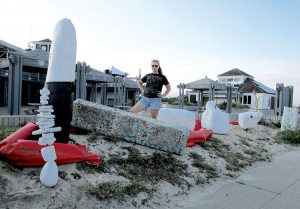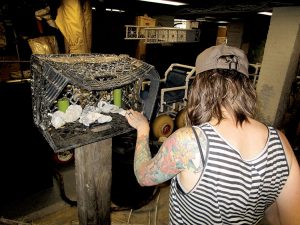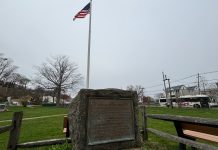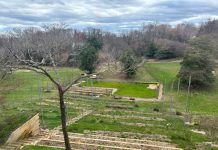Story and photos by Joseph Sapia
SANDY HOOK – Sculptures crafted from trash materials will be featured at Sandy Hook’s Fort Hancock Sept. 17-18, as part of the Zero Waste Arts Fest. Some of it is on view now.
“Gateway to the Arts,” is billed as a marriage of art, environmentalism and history. It is a project by the Monmouth County Arts Council and the National Park Service (NPS).
The Red Bank-based arts council wanted to take note of this year’s coincidental timing of anniversaries: It is the 100th year of Gateway National Recreation Area, of which Sandy Hook is a part – as well as the 50th anniversary of the National Endowment for the Arts (NEA).
“We were thinking, what can we do?” said Mary Eileen Fouratt, the former arts council executive director. Together with Clean Ocean Action (COA), they came up with the idea of repurposing debris from COA cleanups.
Pete McCarthy, the NPS coordinator at Sandy Hook, said, “It’s a different way of looking at our waste.”
But he added, “It addresses a topic at Sandy Hook that we have to get people to recognize, what garbage does to the resource,” said Pete McCarthy, the NPS coordinator at Sandy Hook. “You really need to bring attention to take care of the resource. Our mission is to preserve and protect the resource for future generations.”
Aside from litter left on the beach, Sandy Hook is subject to litter washing ashore from the ocean.
Local environmental artists were matched with environmental or science groups based at Sandy Hook.
Angeles Cossio is partnering with the American Littoral Society (ALS). Her artwork, 6- foot-tall clear tubes filled with plastic garbage she picked up during walks at Sandy Hook, will be displayed at the Gunnison Beach parking area.
“I was, ‘I got the nude beach!’” said Cossio, 42, of Jersey City. “It’s cool. I’ve done a lot of life-drawing (of nudes). If people want to go naked, power to them.”

Laura Petrovich-Cheney, 48, of Asbury Park, will work with Clean Ocean Action. Her medium is plastic foam debris. “The waves had carved them,” she said. “I let nature have a part, do work.”
As artsy as plastic foam looks, it has its negatives – it is pollution, is not bio-degradable and breaks down to small sizes that animals eat, Petrovich-Cheney said.
“It makes sense to use what’s one of their hated items,” Petrovich-Cheney said. “I wanted to shock people by the scale. When you see a 7- foot (plastic foam) obelisk floating in the ocean… If this is what’s floating here, what else is out there? I wanted to show the shapes and size.” Her artwork will be seen at Area D.

Manda Gorsegner, 33, of Atlantic Highlands, is working with the National Oceanic and Atmospheric Administration (NOAA) laboratory. Her artwork will be displayed at Area E. Because of NOAA’s work with artificial reefs in the ocean, Gorsegner will install a series of sculptures. She is using oyster shells salvaged from local restaurants and debris to create a “reef forest.” “There’s just a ton of garbage,” said Gorsegner, the council’s arts education manager, who grew up on Sandy Hook, where her father was stationed with the Coast Guard. “That’s a part of everyone’s project, showing how much garbage there is.”
A fourth artist, Lisa Bagwell, 37, of Red Bank, will build a sculpture during the two days of the festival. She is working with the Sea Grant Consortium. Bagwell said she plans to put a sculpture up beforehand, too – “definitely a piece of marine life, bird or whale,” she said.
“It gives the artists a great opportunity to do something different,” McCarthy said.
Catie Tobin, COA’s marine science programs manager, said the art is to make people aware debris is there, has been collected and should be kept out of the ecosystem. “It’s great we can give this debris a new life (as art),” Tobin said.
Vince Guida, a NOAA fisheries biologist and habitat ecologist, noted the connection being made between science and art on the project. “It’s a nice idea to get people involved and think about it,” Guida said. “People just normally go to the beach, which is understandable. But to see a little beyond that is the whole idea.”
The art project and festival are being funded by an NEA grant of $20,000, along with $20,000 in matching money: $10,000 from the Toms River-based OceanFirst Foundation; $5,000 from the Monmouth County Board of Freeholders; and $5,000 from the New Jersey State Council on the Arts.
The work of the four artists will remain up until the next Clean Ocean Action Beach Sweep of litter Oct. 22, at which point the art can be kept by the artists, donated or recycled.
This story was originally published in the Two River Times August 11 – 18 edition.














